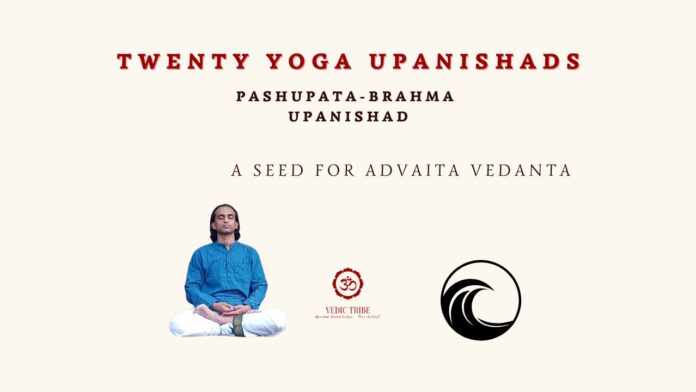A seed for Advaita Vedanta:
In the previous article, we discussed the Yogashiksha Upanishad. In this article, we will discuss Pashupata-brahma Upanishad.
It emphasizes meditation upon “Hamsa & So’ham” aspects of Parabrahma. It goes on to explain vedantic concepts of relationship between atman-brahman-nature, liberation…etc.
Its teachings forms parts of central ideas of Advaita Vedanta and Shaivism.
Hamsa – Soham:
In our article titled “Hamsa Upanishad” the symbolism of Hamsa (Swan) is explained in detail.
So’ham: It apparently means – “He is I”. In Advaita Vedanta, it is interpreted as “Jeevatma IS Paramatma”. In Tattva-vada (Sri Madhwacharya’ s teachings) – it is interpreted as “I am his image”. In Tattva-vada, Jeevatma is the reflection of Paramatma and hence “So’ham”. Also, “So’ham” is another name of Parabrahman.
Hamsa: If “Hamsa” is one face of the coin, “So’ham” is another face. In the practice of Pranayama, while inhaling “Hamsa” aspect of Parabrhama should be meditated upon and while exhaling “So’ham” aspect should be meditated upon. One can observe that the inhalation has a subtle sound “hamsa” and exhalation has the subtle sound “so’ham”.
Prana Yajna: The Pashupatha-Brahma Upanishad says – realization of Hamsa-So’ham is equal to have performed all Vedic Yajnas. In Bhagavad Gita, Lord Krishna calls the said practice of pranayama as Yajna (4: 29-30)
Contemplation on “Maya”:
Darkness and light: The Upanishad equates “Maya” with darkness and “Paramatman” as light. It goes on to discuss that only light exists and darkness is just absence of light. Advaita Vedanta discusses this idea further and states that “absence of knowledge” about Paramatman is “Maya” and once Jeevatma has this knowledge it observes unity with Paramatman.
Comprehension: In Tattva-vada, it is discussed that “maya” is the indecipherable attributes of Parabrahman. It is comprehendible to some extent and remains uncomprehended to a large extent. Jeevatma’s inability to comprehend Brahman is “maya”.
Shaivism:
Kashmir Shaivism: This school of Shaivism, in particular, exhibits a strong influence from Advaita Vedanta. This school of Shaivism emphasizes the oneness of Shiva and the universe, with the world being seen as a manifestation of Shiva’s consciousness. While sharing the concept of non-duality, Kashmir Shaivism differs from Advaita in its emphasis on the dynamic nature of reality, with Shiva’s Shakti (power) playing a crucial role in the manifestation of the universe
Purusha: Both Yoga and Shaivism place a high emphasis on consciousness as the fundamental reality.
The concept of Shiva as pure consciousness is central to Shaivism, and this aligns with the yogic understanding of Purusha.
Tantra: This influential Shaiva tradition is deeply rooted in Tantric teachings. It emphasizes the recognition of Shiva as the ultimate reality and the realization of one’s own identity with Shiva through Tantric practices.
In essence, teachings of Yoga Upanishad like Pashupatha Brahmana Upanishad have strongly influenced the teachings of Advaita and Shaivism.
Key takeaways:
– Study Pashupatha Brahmana Upanishad and understand its essence from scholars
– Also study Tattva-Vada for opposing views and appreciate the diverse nature of the Vedic tradition
In the next article, we will discuss – “Yoga-Kundalini Upanishad”.
Madhwesh K
Vedic Tribe

